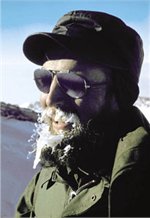Monthly News Summary- January 2005
Data and Imagery
MODIS illustrates rare snow cover: National Weather Service forecast offices in Corpus Christi, TX and Houston/Galveston, TX used MODIStrue color images procured from the MODIS direct broadcast site. The images they chose showed the rare snow cover from the recent snow events.
Wave images on the local news:
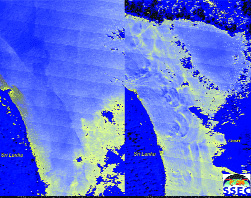 |
|---|
|
Dec. 26 MODIS images of Sri Lanka’s coast enhanced by David Santek using McIDAS
|
SSEC researacher David Santek used McIDAS to process and enhance raw images of Sri Lanka taken from Terra, one of NASA’s research satellites. The satellite took theses images shortly after the tsunami hit Sri Lanka on Sunday, December 26. WISC-TV (Madison Channel 15) used an image of the churning seas off the coast of Sri Lanka.The Madison Times also used Santek’s images to accompany an article about SSEC’s images of the tsunami in the Dec. 31st edition.
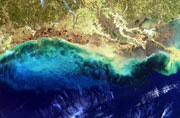 |
|---|
| Image of the Louisianna coast |
In the “dead zone”: The National Science Foundation video production affiliate, ScienCentral, Inc., featured an SSEC image with an article about the Louisiana coast in their online news section. Titled “The Dead Zone,” the article discussed areas in the oceans containing very little oxygen. The story also was released to ABC affiliates.
SGI nods at the supercomputer: At the American Meteorological Society’s Annual Meeting in January, the Silicon Graphics’ (SGI) booth featured their supercomputer, which is the same one CIMSS selected to use for weather forecasting. The computer, SGI Altix 3700, supports the design of satellite instruments as well as numerical weather prediction models. CIMSS received the computer in October.
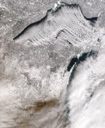 |
|
Gumley’s winter in Wisconsin image used in Medaris’ blog
|
Blogger takes note: David Medaris, a long-time staff writer for Isthmus, works closely with Terri Gregorywhen covering weather news. Medaris and Gregory exchange information on a regular basis. Recently, Medaris started what is essentially a Web log and SSEC appeared as one of the first features. In his blog, Medaris also links to Liam Gumley’s winter-in-Wisconsin image and has myriad compliments about the center.
Honored for teaching: On Jan. 12, Emeritus Professor Donald R. Johnson, a senior scientist in SSEC, received an award for Teaching Excellence at the 85th American Meteorological Society Annual Meeting. Johnson taught meteorology at the University of Wisconsin–Madison from 1964–1994. Currently, he leads a modeling group at SSEC, is special projects scientist for the National Weather Service and directs Earth Sciences for the Universities Space Research Association in Columbia, Maryland. Johnson’s students include many meteorology luminaries: John Zillman, former Director of the Australian Bureau of Meteorology and President of the World Meteorological Organization; Richard Anthes, President of the University Corporation for Atmospheric Research; Louis Uccellini, Director of NOAA’s National Centers for Environmental Prediction; and many others.
Prepare to transfer: The Cooperative Institute for Meteorological Satellite Studies (CIMSS) recently incorporated the GOES Clear Sky Brightness Temperature (CSBT) processing system into the Concurrent Versions System (CVS) repository. They also put the system onto a Linux platform and altered it to match up with a Unix computer. This was done in preparation the processing system for a transfer to the National Environmental Satellite, Data, and Information Service (NESDIS).
A cloudy comparison: Recently, scientists with CIMSS compared the cloud top temperature and emissivity products based on data from the Clouds from AVHRR Extended (CLAR-x) project with similar products developed using data from MODIS. The newly improved CLAR-x algorithm now produces data quite similar to that from the MODIS CO2 slicing algorithm. The improved algorithm also manipulates the data from imagers on GOES-9 and GOES-10.
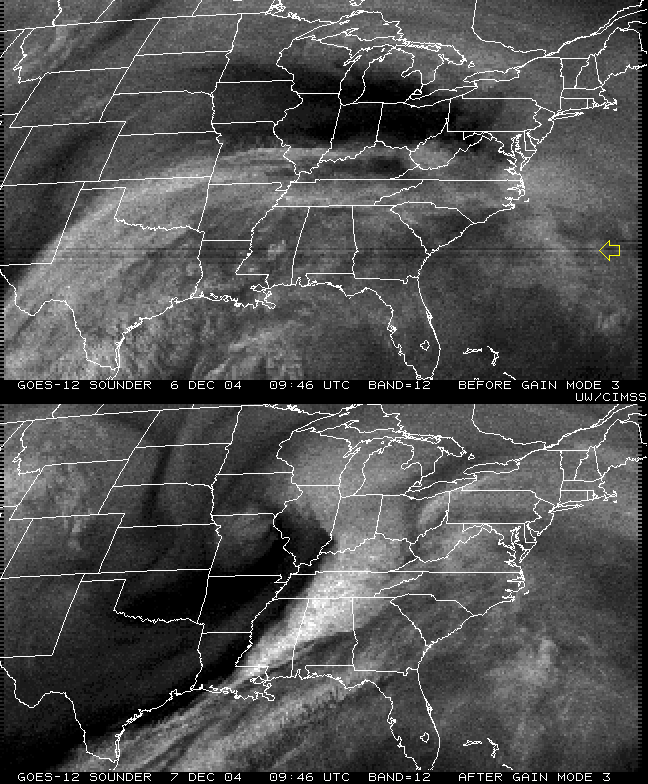 |
|
top image taken before switching to mode 3, the bottom after. click for an enlarged version
|
Switching it up: On Dec. 6, controllers switched the sounder on GOES-12 to a different calibration mode. This mode involves averaging long-term data of the satellite’s infrared calibrations. Switching to the mode will reduce data stripping, allowing more accurate readings. NESDIS and CIMSS collaborated on the mode switch.
CRAS Appreciated:Fernando Torena, a weather forecaster for Base Cientifica Antartica Artigas (BCAA), wrote from King George Island in Antarctica. Torena uses the CIMSS Regional Assimilation System (CRAS)- “an excellent model”- and appreciates that it is provided freely over the Internet. Along the same lines, CIMSS computer programmer Tom Whittaker pointed LA Times graphics reporter Cheryl Brownstein-Santiago to the CRAS forecast site to illustrate jet stream patterns. She wanted to show changes for the eastern Pacific and the U.S. West Coast for the beginning of January. Whittaker also directed her to the official Weather Service forecast model output. You can compare the two, if you wish.
Teaching tools: QuizImage, a tool developed by Tom Whittaker andSteve Ackerman, is noted in “Engage—New e-Learning tools” in Computing @ UW–Madison, the pull-out section in Wisconsin Week for Dec. 8. QuizImage lets a teacher “rapidly create images with hotspots.” Whittaker is a computer programmer specializing in Java programs, Ackerman directs the Cooperative Institute for Meteorological Satellite Studies and teaches in the Department of Atmospheric and Oceanic Sciences. QuizImage and ConceptTutor, both interactive teaching tools, will be released in January by Engage, a DoIT group that helps instructors develop multimedia and other new teaching tools.
UW covers the story hour
Snowy story hour: On Dec. 20, SSEC’s library folks conducted a story hour at the Allied Learning Center, a collaborative effort with theMadison School and Community Recreation program. The SSEC hour was about snow, centering on a children’s story about Wilson Bentley. The program serves an outreach function, tapping into the expertise and materials resources of UW-Madison Libraries and involves graduate students in Library and Information Studies specializing in children’s literature. Don Johnson, of the UW-Libraries Communications Office provided publicity for the story hour program earlier in December and did a piece about SSEC’s hour– first, to cover the outreach aspect and second, because the Schwerdtfeger Library won a grant from the Friends of the UW-Madison Libraries for initial funding of the Bentley archives. Jean Phillips, librarian for SSEC’s Schwerdtfeger Library, hopes the program will generate enough interest so that similar programs can continue. Also, Andy Hall of the Wisconsin State Journal, covered the story hour and published a related article on Dec. 21.
TRMM to continue…for now: by Terri Gregory On Jan. 4, NASA announced that it will continue to operate the Tropical Rainfall Measuring Mission (TRMM) spacecraft through the spring of 2005. NASA had planned to decommission the spacecraft in 2004, ahead of schedule, but several scientists who have projects dependent upon data from the spacecraft protested. The National Academy of Science’s (NAS) Committee on the Future of the Tropical Rainfall Measuring Mission released a preliminary report, strongly recommending continuation of TRMM “at least until such time as a decision on controlled reentry becomes unavoidable.” NASA acknowledged that “TRMM has yielded significant scientific research data over the past seven years to users around the globe, four years beyond its original design life. TRMM data has aided the National Oceanic and Atmospheric Administration (NOAA) and other users in their scientific research, understanding of rainfall and storm prediction, and by demonstrating its benefits in operational forecasts.” SSEC’s Chris Velden is a member of the NAS Committee recommending continued TRMM operations. Velden said that the Committee “made a strong case for extending TRMM to its fuel depletion point (another 5–6 years).” The committee’s full report is due this summer.
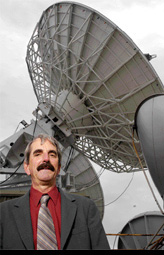 |
|
Hank Revercomb, SSEC’s new director, as featured in Madison Magazine
|
Singing the director’s praises: In the January 2005 issue of Madison Magazine, the city learned of Hank Revercomb’s appointment as the director of SSEC. Reporter Keely Kotnik detailed Revercomb’s achievements, awards and goals for the center. “Like most scientists, Revercomb didn’t start out with the kinds of lofty goals he has now achieved, the ones that history will remember kindly,” Kotnik wrote.
Checking out the oceans from space: In the edition for the week of Dec. 31, The Madison Times ran an article about SSEC images of the tsunami that crashed upon Southeast Asia on Dec. 26. Terri Gregoryprovided the information for the artcile, titled “Tsunami wave effects glimpsed from space.” David Santek’s images were used.
Dirt awarded: John Norman, UW-Madison soils department, won the AMS 2005 Award for Outstanding Achievement in Biometeorology. Norman works with SSEC researchers on agricultural modeling and other research projects.
Air time: NOVA, a WGBH Boston production, will use a Hurricane Ivan movie in a forthcoming program. The program is scheduled to run on PBS stations on January 25. Check listings for local times.

